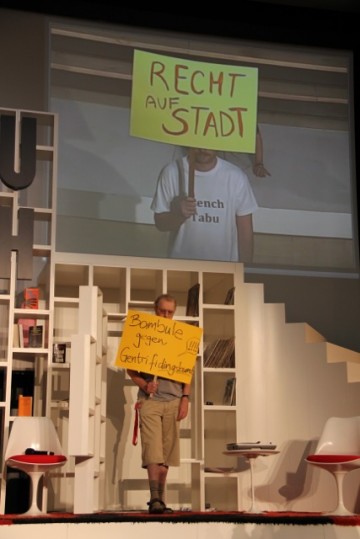Art is not sustainable
Dora wrote...
Says Matthias von Hartz.
The show on August 31 was a very special one. Here the official summary: AUGUST 31, POLITICS, PERFORMANCE, AND THE RIGHT TO THE CITY. Or How performance is politics. Theater curator Matthias von Hartz and journalist and activist Christoph Twickel are guest at the Steal Me show with the moderation of Ellen Blumenstein. They discuss how much art needs politics and how much politics needs art. Following a tradition of art and street activism, the show ends in a rather unusual manner, with the audience, the guests, and the TV crew leaving the Klau Mich stage to go to demonstrate on the street, with the soundtrack of Elvis Presley’s Viva Las Vegas.
However, a quote by Matthias von Hartz really caught my attention: art is not sustainable. In which context was it said?
“The museum is one of the few places where you don’t have to consume, where you don’t have to shop. I started to use the City Theater as a political space and within no time people where coming to me to use the Theater to defend their causes. And this was quite unusual in a city like Hamburg.
Art can be a protective space.
But is art political? there is the consensus that dOCUMENTA 13 is a political space. But there is a danger to it. Whenever you see something extraordinary, a demonstration, you may dismiss this with the words “It is just art”. So the danger of blurring art and politics is that both lose their edge. That both become domesticated.
It would be good indeed if art become more “real”, closer to the reality of the citizen. Intervention in reality is fundamental to art. Art produces live performances in places that were neglected and boring. Art is an important tool for urban development. And in this respect it has a double role, and art should be aware of this duplicity. Performance on the one hand, and political involvement on the other.
So, regarding dOCUMENTA, the fact that the art festival is using so many off-spaces, almost squatting some of them, is perceived by the real state of the city as something very positive, because almost immediately these places will double their economic value. Art has that power, but the problem, is that art is not sustainable. Is not really challenging when an artist comes and does his or her part in a certain building or neighborhood of the city and then leave. Art should be able to keep its engagement for a longer period of time, transforming really the place.
But this seems to go against all the dynamics of exhibitions, institutions, curators, and art consumerism.





